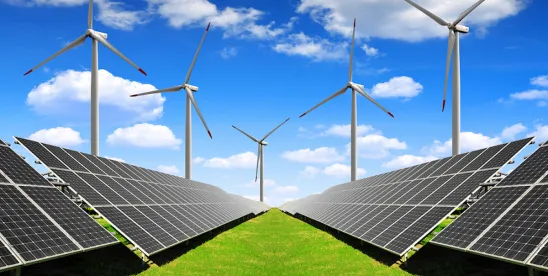- As the Trump administration rolls out its AI Action Plan, which we will separately cover in depth in the next few days, with goals to keep government oversight to a minimum and prioritize innovation, the initial EOs have made clear the administration’s intention to focus on strengthening AI infrastructure and boosting US tech exports to expand global access.
- As part of that effort, the Trump administration has issued a directive that centralizes control of wind and solar projects on federal lands under Interior Secretary Doug Burgum, requiring his personal approval for virtually all aspects of these developments. This is seen as an attempt to hamstring the renewable energy industry, aligning with President Trump's broader efforts to favor fossil fuels and undermine clean energy through the expansion of AI data centers as well. It could significantly delay or derail many projects, including those on private land that intersect with federal property, creating a bottleneck that industry leaders and bipartisan lawmakers fear will raise energy costs and impede US power supply.
- Separately, President Trump and US Senator Dave McCormick (R-PA) highlighted $90 billion in artificial intelligence and energy investments to Pennsylvania during the Energy and Innovation Summit last week. This comes as several Big Tech companies are preparing and attempting to secure enough electricity deals to power data centers for the expansion of AI.
President Trump’s AI Action Plan
President Trump and the White House have officially unveiled the AI Action Plan. This follows the President repealing former President Joe Biden’s 2023 executive order that placed safeguards on AI innovation back in January. Its goals include cutting back environmental requirements and streamlining permitting policies that will allow for data centers and power infrastructure to be easily built. We will write in more detail about these developments as they become public.
He is also expected to sign three artificial intelligence executive orders:
- Targeting “woke” AI models, in which the Trump administration has alleged that some tools and chatbots built showcase political bias
- Creating an easier process for companies to build data centers for AI expansion
- Encouraging exports of American technologies by leveraging US government’s development finance institution
As global competition to dominate AI grows with China, these executive orders follow congressional hearings where Republican lawmakers have favored increasing energy production to power data centers and avoiding regulations that could limit the development of AI models.
From February to March, the Trump administration formally solicited public input via Request for Information (RFI), receiving over 10,000 comments from a wide range of interested parties, including academics, industry leaders, and state and local governments. Submissions from major tech firms underline the industry’s desire for an aligned national strategy. One company urged regulatory preemption, export control revisions, infrastructure expansion, and broader government AI adoption, similar to Congress’ attempt to preempt state regulation, which did not survive the gauntlet on the passage of the recent budget legislation. Another commentator proposed investment in energy and data infrastructure alongside export policy reform, and higher-education groups pressed for workforce development and AI integration in learning while safeguarding privacy.
Those in support approve of the plan’s deregulatory framing, arguing that it removes “unnecessarily burdensome regulations,” but critics warn that the absence of oversight could unleash dangerous systems capable of bias, misinformation, privacy violations, and other societal harms.
Several critiques have arisen from labor, environmental, and civil rights groups that have signed a “People’s AI Action Plan,” calling to prioritize the public over the interests of Big Tech and oil. One executive said, “The rollout of the technology is acting in ways that push down wages, that devalue our work, that are harming our environment and affecting community health.”
Some tech companies and leaders are also opting for a more hands-off approach despite earlier calls for the need for regulation.
At a recent Pittsburgh summit where over $90 billion in data center and energy investments were announced, the Trump administration reinforced its alignment of AI expansion with fossil fuel-friendly policies. Trump’s Office of Science and Technology Policy dismissed critics, arguing that fear-based policy only benefits adversaries like China.
The administration’s approach echoes industry concerns, as the tech sector views reliable energy access as the biggest barrier to AI growth, while environmental groups warn this could dramatically increase greenhouse gas emissions and strain the electric grid.
Trump Administration Issues Directive Centralizing Control of Wind and Solar Projects
A new directive issued by the Trump administration is requiring all solar and wind projects to be approved by Interior Secretary Doug Burgum, including oversight over permits, siting, and right-of-way requests. Some have argued that this process will significantly slow approvals and construction of wind, solar, and transmission projects that need access to federal lands or right-of-way requests managed by the Interior Department.
As we covered, under part of the tax-cut and spending bill signed earlier this month, federal tax credits are set to expire, and this action will potentially limit projects that need to be approved and underway quickly to qualify.
President Trump seeks to enhance federal support for fossil fuels such as coal, oil, and natural gas rather than renewable energy. On July 7, an executive order was signed to further restrict subsidies for unreliable “green” energy sources, shortly after dismantling the 2022 climate law passed under President Joe Biden.
In addition to concerns from energy companies, lawmakers in both parties have also voiced concerns about potential roadblocks. Republicans worry the move sets a precedent that could later be used against fossil fuel projects by a Democratic administration, while Democrats argue the directive will raise electricity prices and stifle cheaper renewable energy just as demand rises. The directive itself could potentially hinder US power supply growth and jeopardize hundreds of renewable energy projects as demand increases from artificial intelligence and data centers.
Senator Shelley Moore Capito (R-WV), Chairman of the Environment and Public Works Committee, voiced concerns about possible delays in approving energy infrastructure, stating, “Every energy project needs to be permitted as fast as possible regardless of resource.” Senator Martin Heinrich (D-NM), the top Democrat on the Energy and Natural Resources Committee, said that if this is created as a precedent, “a future administration could play the same game with oil and gas pipelines and leases.”
Renewable sources made up 93% of new US power capacity last year, highlighting their growing role.
We will provide a report highlighting the directives in the AI Action Plan in detail and the executive orders to come.






 />i
/>i

